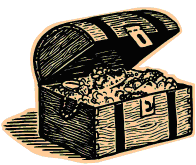Ask Professor Puzzler
Do you have a question you would like to ask Professor Puzzler? Click here to ask your question!
We've had several questions recently about how to find terms of a geometric sequence, if you've been given specific information about the sequence, such as, what two of the terms are.
So let's consider a couple examples. For starters, let's say we have a sequence in which the second term is 4, and the fifth term is 27/2. How do we find the first term and the common ratio?
First, since the nth term is arn-1, we know that ar = 4, and ar4 = 27/2. So what do we do with these two pieces of information? Well, we can take the second equation and divide it by the first one, to obtain r3 = 27/8, or r = 3/2.
Since we know that r = 3/2, we can plug that into our first equation, and get (3/2)a = 4, so a = 8/3.
Not too bad, right?
So let's try another one that works out to be just a little different.
If the second term is 24, and the fourth term is 6, find the first term and the common ratio.
We start out the same way:
ar = 24, and ar2 = 6. Dividing these two equations gives r2 = 1/4.
At this point, it's tempting to take the square root of both sides and say r = 1/2. (I see algebra students do this all too often!)
However, it's important to remember that 1/4 has TWO square roots: 1/2 and -1/2.
This means there are TWO possibilities for a. If r = 1/2, then a = 48, but if r = -1/2, then a = -48.
As a general rule of thumb, if you're given two terms of the same parity (both odd numbered terms, or both even numbered terms) you're going to have two possible solutions.
Thanks for asking, and good luck with your sequences!
Professor Puzzler
Disclaimer: The following post is not a serious suggestion that we should revamp the way we teach students to learn addition. It's merely an interesting thought experiment.
It's true. You don't need all those addition facts. You spent hours and hours and hours memorizing 100 addition facts (0 through 9 plus 0 through 9). Okay, actually, you didn't learn 100 of them, because you learned that addition is commutative (5 + 7 is the same as 7 + 5, so you just need to memorize one of them).
But you don't need all those facts. You just need 25 of them (arguably, only 20*). Here's what you really need: 1. math facts for all whole numbers less than 5; and 2. and all the "fives" facts:
"Less Than Five" Table
0 + 0 = 0
0 + 1 = 1
0 + 2 = 2
0 + 3 = 3
0 + 4 = 4
1 + 1 = 2
1 + 2 = 3
1 + 3 = 4
1 + 4 = 5
2 + 2 = 4
2 + 3 = 5
2 + 4 = 6
3 + 3 = 6
3 + 4 = 7
4 + 4 = 8
"Fives" Table*
0 + 5 = 5
1 + 5 = 6
2 + 5 = 7
3 + 5 = 8
4 + 5 = 9
5 + 5 = 10
5 + 6 = 11
5 + 7 = 12
5 + 8 = 13
5 + 9 = 14
That's a total of 25 addition facts. And you can do all addition problems with just these, as long as you're willing to mentally split numbers that are bigger than 5.
Here's what I mean. Suppose you have to add 4 and 8, but you don't remember what 4 + 8 is. What do you do (besides counting on your fingers!)? You split the 8 into 5 and 3 (because, according to your "fives" table, 5 + 3 = 8). So now you have 4 + 8 = 4 + 5 + 3. Since two of those numbers are less than five, you know their sum: 4 + 3 is 7. Now use your "fives" table to get 7 + 5 = 12.
Let's try another. Add 7 and 9. Split one of those up using the "fives" table: 7 + 9 = (5 + 2) + 9. Since we have our fives memorized, we do 5 + 9 = 14. Now, since we know 4 + 2 = 6, 14 + 2 = 16.
We could have done the problem by splitting 9 instead of 7: 7 + 9 = 7 + (5 + 4). You know 7 + 5 =12, and since 2 + 4 = 6, 12 + 4 = 16.
The process is:
- Split the larger number using your "fives" table.
- If you now have two numbers less than five, use your "less than five" table, followed by your "fives" table
- Otherwise, combine the number that's bigger than five with the five, using your "fives" table. This will result in a carry, and then you can use your "less than five" table.
* The "Fives" table is actually shorter than this. You only need to remember the pairings:
0 and 5
1 and 6
2 and 7
3 and 8
4 and 9
For example, consider the pairing 4 and 9. 5 + 4 = 9, and 5 + 9 = 4 (plus a carry).
This brings the total number of necessary facts to 20.
Or you could, you know, just bite the bullet and memorize all of them. :D
Krish asks, "In your base 11 Vortex Math, what brought you to begin with the number 2 rather than 1?"
For those who don't know what this question is in reference to, you'll want to visit our Vortex Based Mathematics page, where we explore (for a little bit of fun and enlightenment) what Vortex Based Math would have looked like if Marko Rodin was the proud owner of eleven fingers instead of just ten. It's a bit tongue-in-cheek, but it's a way of helping people understand the fundamental concept that Marko missed out on: bases.
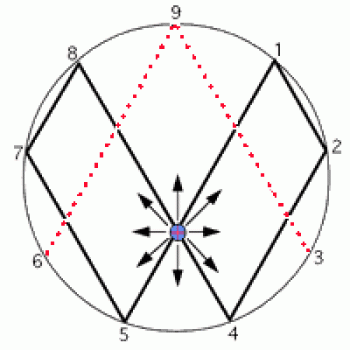
In Marko's base ten diagram (which he and his followers have been known to refer to as an equation, even though picture and equation are not even remotely similar), Marko uses a doubling process to create a "loop" of numbers.
The numbers 1, 2, 4, 8, 7, and 5 each map to the next number in the sequence, with the number 5 mapping back to the number 1.
This produces an approximate infinity symbol, which, to Marko's way of thinking implies that this is going to result in an infinite supply of energy for everyone.
So my imaginary Seussian friend from Wunfishia, whose name is Marko-11 (because he has eleven fingers) did the whole process in base eleven. And his diagram looks like the one over on the right.
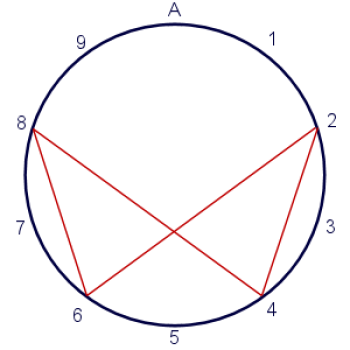
Notice that Marko-11 skipped over the number 1, and started his loop with the number 2. This is the source of Krish's question: "what brought you to begin with the number 2 rather than 1?"
The answer to that question might surprise you: I didn't start with the number 2; I started with the number 1! This was when I was doing the math for myself before I started writing up the page. 1 maps to 2, 2 to 4, and so forth. I was actually a little surprised when the mapping from 6 went back to 2 instead of to 1.
That was when I discovered "feeders" - numbers that aren't part of the loop, but feed into it. If you look at the picture below, you'll see that in base eleven, the vortex diagram has four feeders - four numbers that are not part of the loop, but feed into it.
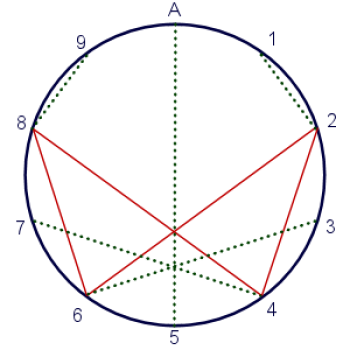
Once I understood that, I realized that it would be simpler to start with 2 when I was explaining VBM-11, and then show the "feeders" once I established the loop. The reason for doing that was purely pedagogical; I thought it would be easier for people to understand if I fully explained one concept before moving on to the next.
So let's wrap up with one more interesting question (which I have not yet explored):
In some bases, the loop starts with the number 1, in some bases it starts with the number 2, and in some cases it even starts with 3 or 4 (here's an example that starts with 4: Vortex-29). The question is: what is the pattern? Someday I may explore that question mathematically, but in the meantime, if you go to our Vortex-n-k simulator page, the website will do all the doubling and looping math for you, so you can quickly scroll through various vortex diagrams and see which loops start with 1, and which ones don't.
Have fun!
Professor Puzzler
Dear Professor Puzzler, I read that if a polynomial equation has degree 2, there are two solutions, if it's degree three, there are three solutions, and so on. Is this true? Lucia
Well, Lucia,
It's true, and it's not true. It's true, with a couple of clarifications. Let's take a look to see a couple examples.
Example One: A Perfect Square
x2 + 6x + 9 = 0
How does this factor?
(x + 3)(x + 3) = 0, or (x + 3)2 = 0.
This gives us only one solution: x = -3. So the rule you read isn't exactly right in this case.
Example Two: A "Complex" Polynomial
Consider this one: x2 + 9 = 0.
This can't be factored, and yet, if you know complex numbers, you can do this to it:
x2 = -9
x = 3i or -3i.
So we need to revise your rule a bit:
If you have a polynomial equation with degree n (n a positive integer), the number of solutions is n, as long as we agree to count repeated solutions once for each occurrence, and we allow for complex solutions.
So, for example, if you have an ugly polynomial like this:
x5 - 3x4 + 7x3 - 13x2 + 12x - 4 = 0
It can be factored as follows: (x - 1)3(x + 2i)(x - 2i) = 0.
The solutions are: 2i, -2i, 1, 1, and 1, for a total of 5 solutions, which matches the degree of the polynomial.
By the way, if you're wondering how I factored x5 - 3x4 + 7x3 - 13x2 + 12x - 4, that's a post for another day!
Professor Puzzler
Sixth grader Abdulla from U.A.E. asks the following question: "Are there perpendicular sides in trapezoid?"
The answer to that question, Abdulla, is "sometimes yes, sometimes no."
When people say the word "trapezoid," the image that automatically conjures up for most people looks like this:
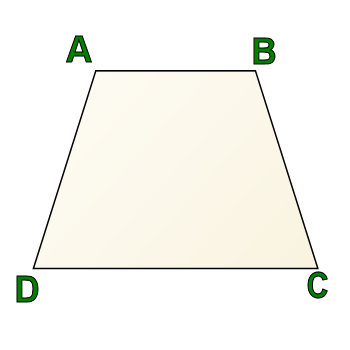
This is a trapezoid, and it is often described as a triangle with the top lopped off, or as a "dog food dish."
In this particular trapezoid, there are no perpendicular sides. A and B are both obtuse angles in this diagram, and C and D are both acute angles.
However, not all trapezoids look like this. Let's talk for a moment about the definition of a trapezoid.
Interestingly, the definition of "trapezoid" will vary depending on the part of the world in which you live, and in some parts of the world, the word "trapezium" is used for what I refer to as a trapezoid. I'm going to show you two definitions of trapezoid, and you'll need to check with your teacher/textbook to find out which way of defining a trapezoid is used in your part of the world.
Definition A: A trapezoid is any quadrilateral with exactly one pair of parallel sides.
Definition B: A trapezoid is any quadrilateral with at least one pair of parallel sides.
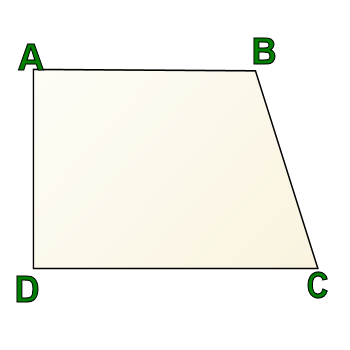
Regardless of which definition you use, the following is a trapezoid:
AB is parallel to CD still, so it meets definition B, and since AD is not parallel to BC, it also meets definition A.
This trapezoid is called a "right trapezoid." Why? Because always true of trapezoids (regardless of your definition): Right angles come in pairs in a trapezoid.
Why? Because
So this answers your question: Yes, some trapezoids have perpendicular sides.
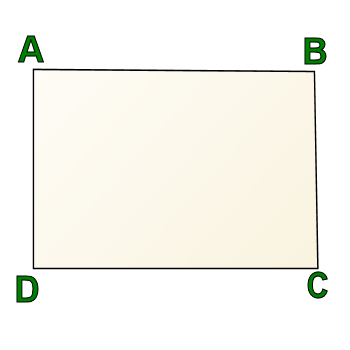
Let's take this one step further, though. Here's another figure. In this one, you have four right angles. That makes this a rectangle.
But is this figure also a trapezoid? It depends on whether you're using definition A or definition B.
If you're using definition A, it absolutely is not a trapezoid, because it has two pairs of parallel sides.
However, if you're using definition B, having two pairs of parallel sides is okay.
So if you're using definition B, then a trapezoid could be made up entirely of right angles, and a rectangle would be a special kind of trapezoid.
Otherwise, if you're using definition A, the most a trapezoid could have is two right angles, and therefore, two perpendicular sides.
Hope that helped answer your question!
Professor Puzzler

